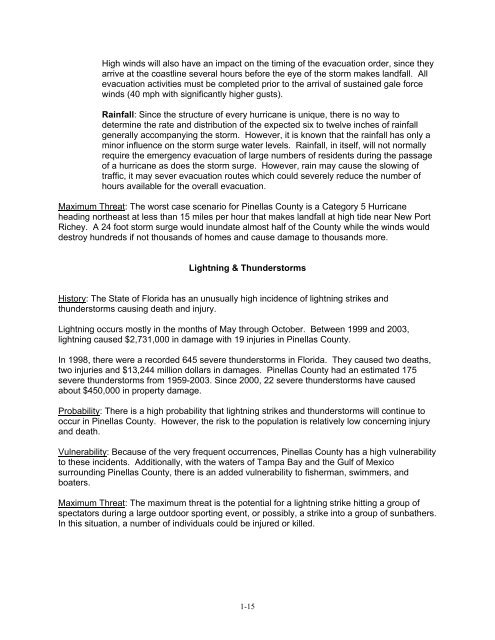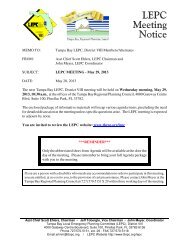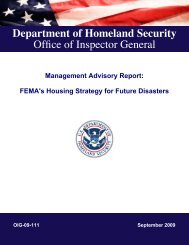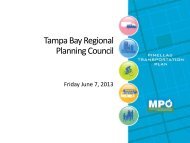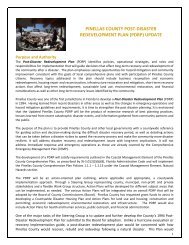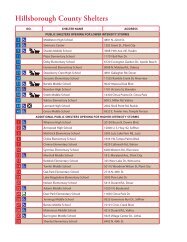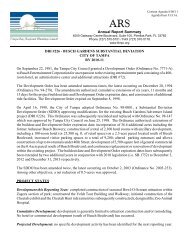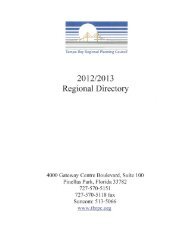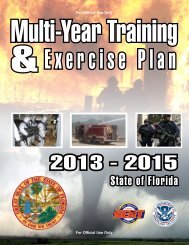FEMA Approved LMS Plan - Tampa Bay Regional Planning Council
FEMA Approved LMS Plan - Tampa Bay Regional Planning Council
FEMA Approved LMS Plan - Tampa Bay Regional Planning Council
You also want an ePaper? Increase the reach of your titles
YUMPU automatically turns print PDFs into web optimized ePapers that Google loves.
High winds will also have an impact on the timing of the evacuation order, since they<br />
arrive at the coastline several hours before the eye of the storm makes landfall. All<br />
evacuation activities must be completed prior to the arrival of sustained gale force<br />
winds (40 mph with significantly higher gusts).<br />
Rainfall: Since the structure of every hurricane is unique, there is no way to<br />
determine the rate and distribution of the expected six to twelve inches of rainfall<br />
generally accompanying the storm. However, it is known that the rainfall has only a<br />
minor influence on the storm surge water levels. Rainfall, in itself, will not normally<br />
require the emergency evacuation of large numbers of residents during the passage<br />
of a hurricane as does the storm surge. However, rain may cause the slowing of<br />
traffic, it may sever evacuation routes which could severely reduce the number of<br />
hours available for the overall evacuation.<br />
Maximum Threat: The worst case scenario for Pinellas County is a Category 5 Hurricane<br />
heading northeast at less than 15 miles per hour that makes landfall at high tide near New Port<br />
Richey. A 24 foot storm surge would inundate almost half of the County while the winds would<br />
destroy hundreds if not thousands of homes and cause damage to thousands more.<br />
Lightning & Thunderstorms<br />
History: The State of Florida has an unusually high incidence of lightning strikes and<br />
thunderstorms causing death and injury.<br />
Lightning occurs mostly in the months of May through October. Between 1999 and 2003,<br />
lightning caused $2,731,000 in damage with 19 injuries in Pinellas County.<br />
In 1998, there were a recorded 645 severe thunderstorms in Florida. They caused two deaths,<br />
two injuries and $13,244 million dollars in damages. Pinellas County had an estimated 175<br />
severe thunderstorms from 1959-2003. Since 2000, 22 severe thunderstorms have caused<br />
about $450,000 in property damage.<br />
Probability: There is a high probability that lightning strikes and thunderstorms will continue to<br />
occur in Pinellas County. However, the risk to the population is relatively low concerning injury<br />
and death.<br />
Vulnerability: Because of the very frequent occurrences, Pinellas County has a high vulnerability<br />
to these incidents. Additionally, with the waters of <strong>Tampa</strong> <strong>Bay</strong> and the Gulf of Mexico<br />
surrounding Pinellas County, there is an added vulnerability to fisherman, swimmers, and<br />
boaters.<br />
Maximum Threat: The maximum threat is the potential for a lightning strike hitting a group of<br />
spectators during a large outdoor sporting event, or possibly, a strike into a group of sunbathers.<br />
In this situation, a number of individuals could be injured or killed.<br />
1-15


